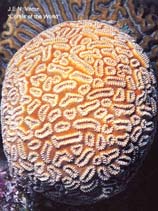Dichocoenia stokesii (Milne Edwards & Haime, 1849)
Pineapple coral
Classification / Names Common names | Synonyms | CoL | ITIS | WoRMS
Hexacorallia | Scleractinia | Meandrinidae
Environment: milieu / climate zone / depth range / distribution range Ecology
Reef-associated; depth range 0 - 72 m (Ref. 847). Subtropical; 33°N - 8°N, 98°W - 58°W (Ref. 847)
Distribution Countries | FAO areas | Ecosystems | Occurrences | Introductions
Western Central Atlantic.
Length at first maturity / Size / Weight / Age
Maturity: Lm ? range ? - ? cm
Short description Morphology
Life cycle and mating behavior Maturity | Reproduction | Spawning | Eggs | Fecundity | Larvae
Main reference
References | Coordinator | Collaborators
MarineSpecies.org. 2050. (Ref. 3477)
IUCN Red List Status
(Ref. 130435: Version 2024-2)
CITES status (Ref. 108899)
CMS (Ref. 116361)
Threat to humans
Human uses
| FishSource |
Tools
More information
Diet composition
Food consumption
Predators
Max. ages / sizes
Length-weight rel.
Length-length rel.
Length-frequencies
Mass conversion
Abundance
Internet sources
BHL | BOLD Systems | CISTI | DiscoverLife | FAO(Publication : search) | Fishipedia | GenBank (genome, nucleotide) | GloBI | Gomexsi | Google Books | Google Scholar | Google | PubMed | Tree of Life | Wikipedia (Go, Search) | Zoological Record



